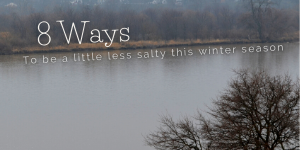 De-icers are great for keeping us safe when we drive or go for walks in the wintertime. But too many de-icers in our waterways can cause permeant damage. Municipalities and homeowners often employ the use of salt to de-ice roads and sidewalks. While this makes it safer to drive or walk, it often creates a dangerous situation for our rivers, streams, lakes, and groundwater. Once the snow has melted, the salt and other chemicals used to de-ice roadways leach into the waterways, changing the pH balance and becoming a permanent pollutant. Unfortunately, there are not a lot of environmentally safe, effective, and inexpensive alternatives to salt. This means the best way to reduce salt in our waterways is to reduce salt at the application source.
De-icers are great for keeping us safe when we drive or go for walks in the wintertime. But too many de-icers in our waterways can cause permeant damage. Municipalities and homeowners often employ the use of salt to de-ice roads and sidewalks. While this makes it safer to drive or walk, it often creates a dangerous situation for our rivers, streams, lakes, and groundwater. Once the snow has melted, the salt and other chemicals used to de-ice roadways leach into the waterways, changing the pH balance and becoming a permanent pollutant. Unfortunately, there are not a lot of environmentally safe, effective, and inexpensive alternatives to salt. This means the best way to reduce salt in our waterways is to reduce salt at the application source.
Tips to reduce the use of salt on your driveway/sidewalk:
- Do not use salt after temperatures reach below 15 degrees Fahrenheit. Salt does not help melt the ice after that point.
- Only use sand as traction. Sand will not melt ice but is a good substitute after temperatures reach below 15 degrees Fahrenheit.
- If you have a chronic problem with ice forming, determine the source and divert the melting snow away from your sidewalks and driveways to an area where the ice will not be a problem.
- Shovel early in the day, the sun will warm the surface and help melt new snow and prevent the need for de-icers.
- Shovel before you drive a vehicle on the driveway to reduce packed snow that can turn icy.
- Limit the use of de-icers, especially those with the most negative impacts to be used only when needed.
- Sweep up extra salt. If it is visible on dry pavement, it is no longer working for its intended purpose and will end up in our water system.
- Do not use fertilizers for snow and ice removal. Fertilizers are very poor at ice melting and removal and melting and increase nutrient runoff to nearby streams.
Remember anything that you put on the surface will flow into our waterways untreated. By following these salting tips, we can limit the amount of chloride pollution that enters our streams, rivers, and lakes during the winter months. Smart application of salt can make it safer for you and safer for your waterways this spring.
Next year, we will be working with University of Toledo researchers and TMACOG to identify local waterways that are significantly impacted by salt pollution as the first step to developing alternatives and best practices that local municipalities and commercial salt applicators can take to better manage the salt application as well.
